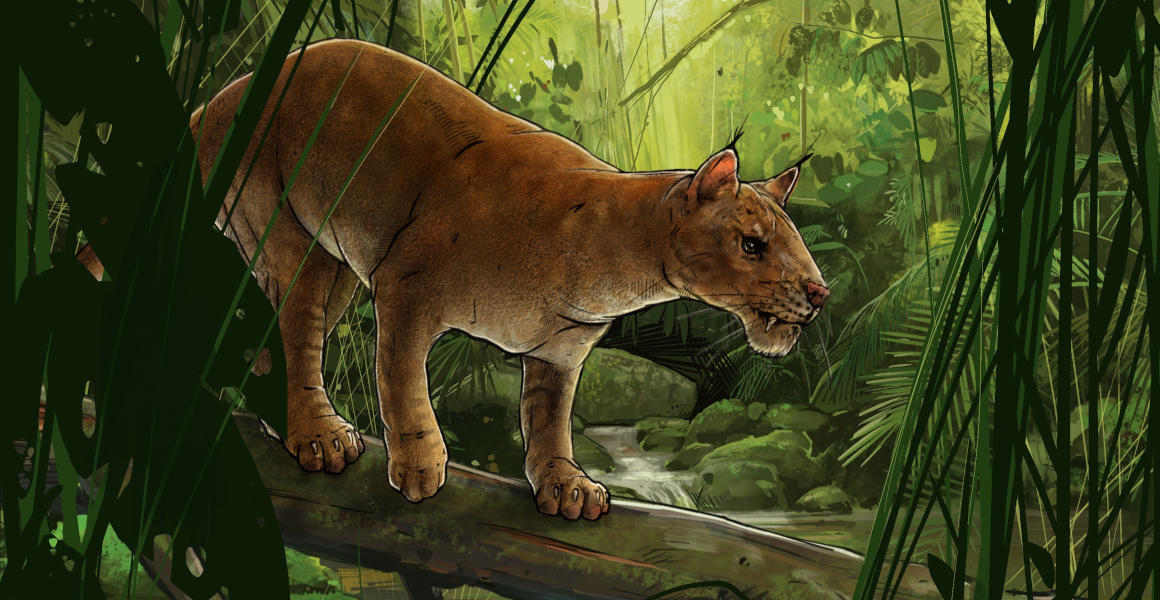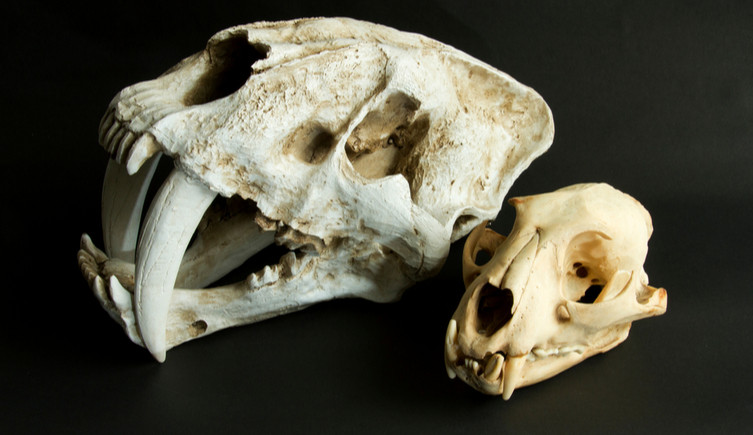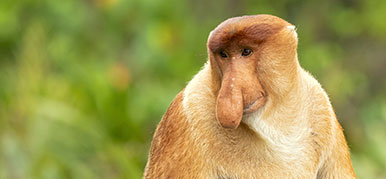One of the oldest sabre-toothed animals has been described in the USA.
Living over 40 million years before the sabre-tooth tiger, Diegoaelurus vanvalkenburghae may have preyed on rhinos and primates in the forests of California.

Diegoaelurus vanvalkenburghae is thought to have hunted on the forest floor and in trees. Image © San Diego Natural History Museum, licensed under CC BY 4.0opens in a new window
One of the oldest sabre-toothed animals has been described in the USA.
Living over 40 million years before the sabre-tooth tiger, Diegoaelurus vanvalkenburghae may have preyed on rhinos and primates in the forests of California.
With serrated teeth and an all meat-diet, you wouldn't want to mess with Diegoaelurus vanvalkenburghae.
With teeth acting like scissors to shear flesh, the cat-like hypercarnivore would have roamed the tropical woodlands of what is now California, targeting prey both on the forest floor and up in trees. It is among the earliest sabre-toothed mammals to evolve, as part of an evolutionary strategy that recurs time after time throughout history.
Dr Ashley Poust, a co-author of the new species' description, says, 'Today the ability to eat an all-meat diet isn't uncommon in mammals. Tigers and polar bears, for instance, can both do it. But 42 million years ago, mammals were only just figuring out how to survive on meat alone.
'One big advance was to evolve specialized teeth for slicing flesh, which is something we see in this newly described specimen. Nothing like this had existed in mammals before.
'A few mammal ancestors had long fangs, but D. vanvalkenburghae and its few relatives represent the first cat-like approach to an all-meat diet, with sabre-teeth in front and slicing scissor teeth called carnassials in the back. It's a potent combination that several animal groups have independently evolved in the millions of years since.'
The description of the species, named after the city of San Diego and sabre-tooth expert Dr Blaire Van Valkenburgh, was published in the journal PeerJ.

The skull of Smilodon (left) shows significantly enlarged teeth that allowed it to become an apex predator. Image © Nick Greaves/Shutterstock
While sabre-tooth animals have been made famous through their appearances in exhibitions and films, they're not a single closely related group of animals. The term refers to a number of groups spanning millions of years which all shared a hypercarnivorous lifestyle that saw them eat extremely high amounts of meat.
Dr Jerry Hooker, an expert in Eocene mammals at the Museum, says, 'The sabre-tooth morphology is a pretty specialised adaptation. There aren't many carnivores today which can tackle a fully-grown large mammal, while sabre-tooths may have been able to do this with suggestions that they targeted the blood vessels of the neck to bring down prey.
'The sabre-tooth form has evolved multiple times throughout history, including in a South American marsupial called Thylacosmilus, the nimravids, also known as the false sabre-toothed cats, as well as cat relatives such as Smilodonopens in a new window, the sabre-toothed tiger.'
Smilodon is perhaps the most famous sabre-tooth of them all, which lived in the Americas during the Pleistocene between 2.5 million and 12,000 years ago. It used its large canine teeth, measuring as long as 28 centimetres, to kill prey using a unique motionopens in a new window of the head in combinations with its powerful forelimbs.
But the high-meat diet of Smilodon was pioneered by earlier animals, of which D. vanvalkenburghae is one. It is a member of a group of mammals known as machaeroidines, which while looking similar to cats, are not closely related to them. Instead, this group of animals branched off from all living carnivores over 50 million years ago, and subsequently went extinct.
'These animals have a different set up of carnassial, or flesh shearing, teeth to modern carnivores,' Jerry explains. 'While carnivores have carnassials towards the front of the mouth, creodonts used different teeth for this job. For instance, hyaenodonts had molars adapted for this function, and because they were closer to the hinge of the jaw they had a more powerful bite.'
While machaeroidines were innovative for their time, not much is known about them. The most complete specimen, a species called Machaeroides eothen, includes a skull and a partial skeleton which has been used to infer what more fragmentary species could have looked likeopens in a new window. While this new species only consists of part of the lower jaw, is one of the more complete species.
Lead author Dr Shawn Zack says, 'We know so little about machaeroidines, so every new discovery greatly expands our picture of them. This relatively complete, well-preserved fossil is especially useful because the teeth let us infer the diet and start to understand how machaeroidines are related to each other.'
The researchers found that D. vanvalkenburghae was one of the latest of the animals to survive, and represents one of the most specialised of its kind.
'D. vanvalkenburghae is a new machaeroidine genus, and while the group is quite diverse, they are very rare,' Jerry says. 'With rare taxa, there is always a danger that the features may be a result of variation rather than speciation, as it is difficult to fully assess changes within a species. However, on balance, I think the authors have made a good case for this being its own species.'

Diegoaelurus vanvalkenburghae was described using a jaw fragment, which is relatively complete for animals of its type. Image © San Diego Natural History Museum, licensed under CC BY 4.0
The jaw of D. vanvalkenburghae has significantly reduced certain teeth, such as the pre-molars, while developing significantly enlarged canines with serrated edges. This would have allowed it to hunt prey larger than its estimated 1.2 metre length, but it wouldn't have been as well-adapted as later sabre-toothed animals like Smilodon to shear flesh from its prey.
However, its small size instead probably allowed it to climb and hunt prey in a range of locations inaccessible to the species which followed in its footsteps.
'The Santiago Formation fossils show us a forested, wet California where tiny rhinos, early tapirs, and strange sheep-like, herbivorous oreodonts grazed under trees while unusual primates and marsupials clung to the canopy above,' Ashley says. 'This richness of prey species would have been a smorgasbord for D. vanvalkenburghae, allowing it to live the life of a specialized hunter before most other mammals.'
It is also possible that the sabre-toothed predator could have lived alongside others of its kind. While a larger relative, Apataelurus, is found in a different area of America at around the same time as D. vanvalkenburghae, the nimravids are known to have arrived around five million years later.
As the intervening period is poorly sampled, the scientists hope to investigate further to see if there is an overlap between these species. Alternatively D. vanvalkenburghae may have been wiped out during the extinction of many other North American speciesopens in a new window during this time.
Despite its extinction, similar adaptations to hypercarnivory have reoccurred many times over the next 40 million years, with Smilodon one of the last sabre-tooths to be recognised.
Even though there are no sabre-toothed animals today, that might not always be the case. Studies of the clouded leopardopens in a new window suggest it could be on the evolutionary path towards becoming one of these predators, bringing the history of the sabre-tooths full circle once more.

Just how weird can the natural world be?
Don't miss a thing
Receive email updates about our news, science, exhibitions, events, products, services and fundraising activities. We may occasionally include third-party content from our corporate partners and other museums. We will not share your personal details with these third parties. You must be over the age of 13. Privacy notice.
Follow us on social media